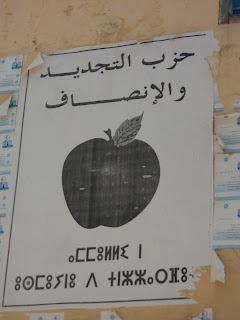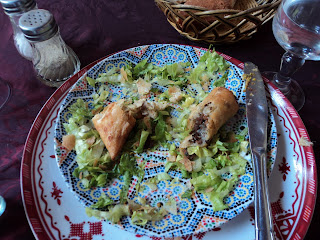
The last stop on my tour of the Middle Atlas region was the imperial city of Meknès. There are four imperial cities in Morocco: Marrakesh, Rabat, Fès and Meknès. Each imperial city is associated with its own imperial color: Red for Marrakesh, yellow for Rabat, blue for Fès, and green for Meknès. You can read all about these imperial cities here.
The natural starting point for my tour of Meknès was the Bab Mansour (Door of the Renegade), the door through which one enters into the old part of the city or the medina. The story goes that this door was designed by a Christian who had converted to Islam (hence, the name "Renegade"). At any rate, the door was completed in 1732 under the rule of Moulay Abdallah, the son of the great ruler Moulay Ismaïl who is buried in a glorious mausoleum here in Meknès.

After entering into the medina, we wandered a bit and came to this beautiful fountain and door decorated in beautiful zellij tile mosaic. It was Friday, the Muslim holy day, so the mausoleum of Moulay Ismaïl would not be open to tourists until after 3pm. We had plenty of time to explore the medina.
As we wandered, we came across a poster for an upcoming election. It is written in Arabic across the top and in Berber across the bottom. Berber uses the alphabet of the Phoenicians. The apple is the symbol of this particular candidate, in case the voter cannot read, candidates are also represented by a symbol on the ballot. Here is a picture of the poster:

We decided to stop for lunch and God intervened. It's moments of complete serendipity that make traveling so unexpectedly memorable and meaningful. Here's what I mean by this: We followed a back alley which most tourists would probably not choose to follow. It was cluttered, dirty, and difficult to access. It led us to a restaurant where we thought we would eat. But, they told us they were full and recommended we continue along this alley until we would find a place called Ryad Meknès where they assured us we would be able to eat lunch. So we followed their instructions and here is the incredibly picturesque door to Ryad Meknès that we eventually came to:

Once inside, we found a very eclectic, traditionally Moroccan décor. All the best of Moroccan decorative arts were on display: pottery, wood carving, tooled leather, brass and silver, mosaic tiles, painted wood frames. It was incredibly beautiful. The tables of the restaurant were set up in shaded patios surrounding a common courtyard filled with all kinds of greenery and iron sculptures. We ate outside, but in a cool, shaded area with a beautiful view. Here is a picture of the courtyard:

And here are some pictures I took of the décor:


The lunch itself was absolutely delicious! The meal began with an array of small bowls each containing a different variety of Moroccan salad: Fresh cucumbers with tomatoes, fresh tomatoes with onion, cooked carrots served cold with parsley, cooked beets served cold with garlic and parsley, cold white rice with cilantro and pepper, cooked potatoes cut into cubes with cilantro and parsley, grilled eggplant with roasted garlic and tomatoes served warm, grilled green bell peppers with grilled tomatoes served warm. Using bread as a scoop, we dipped into the bowls and got a wonderful tasting of Moroccan cooking. Next, I had a serving of braewats. A braewat is much like an egg roll, although it can be a roll, a square, a triangle, or a disk. The fillings can vary. The ones I had for lunch were savory: Spiced ground beef with rice noodles, spiced chicken with rice noodles, white cheese with herbs, and one that tasted just like pastilla with savory chicken, onions, raisins and almonds sprinkled with powdered sugar and cinnamon. Here is a picture of my almost empty plate:

So where is the serendipity in all this? We stumbled upon this restaurant quite by chance. But later, I read in my guide that Ryad Meknès is considered the finest and most authentic dining experience in Meknès! Also, its beautiful locale was once a part of one of Moulay Ismaïl's palaces in Meknès. It is in such a hard-to-find location that I am certain we would have never found it if we had sought it out. Yet, as curious travelers wandering along a path most tourists would never follow, we came upon an unforgettable experience. This is what I call SERENDIPITY!
After lunch, we needed to make our way to the primary purpose of our visit to Meknès: The mausoleum of Moulay Ismaïl. We had no idea how to make it through the winding, narrow streets of the medina to the mausoleum. So, as we left the restaurant, a woman dressed in a traditional djelleba walked by and I asked her in my rudimentary Moroccan dialect how to find our way to the mausoleum. She insisted on walking us through the maze of streets to our destination. Some of the streets were covered and looked like halls in a monastery, such as this picture I took along the way:

This picture is where we came out of the winding streets, just near the mausoleum. The spray-painted horse is another symbol for a candidate in the upcoming elections. It will be interesting to share this detail about political campaigning in Morocco with my students. In many countries where literacy is low, easy-to-remember images are often used by candidates so their constituents will know who to vote for on the ballot.

Our last stop in Meknès was a tour of the mausoleum for Moulay Ismaïl. This is a strikingly beautiful building and one of the few religious sites open to all people, even non-Muslims. (Entrance is free.) You might wonder, who was Moulay Ismaïl? Well, you can read more about him here, but the short version of who he was is this: Moulay Ismaïl was a contemporary of France's King Louis XIV. He sought an alliance with France against Spain and sent an ambassador to the court at Versailles. He requested the hand of Louis XIV's daughter (or perhaps his niece) in marriage, but this request was refused when Louis XIV learned that Moulay Ismaïl had a harem of some 500 women. Instead, Louis XIV sent two large grandfather clocks to Moulay Ismaïl and they now stand on either side of Moulay Ismaïl's tomb inside the mausoleum. Moulay Ismaïl wanted his palace in Meknès to rival Versailles in its beauty. Since that palace is still the private property of the King of Morocco and not open for public viewing, the best we can see in Meknès is this mausoleum. Having been to Versailles, which is an amazingly beautiful place, I can assure you that this Mausoleum is more beautiful and amazing.
Here are the pictures of the mausoleum and my comments ---
The entrance to the mausoleum, just inside this front door there is a fountain for Muslims to perform their ritual ablutions before they pray:

You must pass through prayer rooms to reach the tomb of Moulay Ismaïl. These rooms are still used for prayers, especially on Fridays and holy days. Other members of the royal family since the time of Moulay Ismaïl are also buried in this mausoleum. This is a picture of me next to a doorway leading from one prayer antechamber into another:

This is the entrance from a prayer room into the actual tombs of Moulay Ismaïl, two of his sons, and his most beloved wife. Visitors must remove their shoes and leave them outside these doors:

As soon as you walk through the door in the corner on the far left (picture above), you come to this room (picture below) with another fountain for Muslims to perform their ritual ablutions. This fountain room has a view in to the room for the tombs:
 This is a picture of me washing in the fountain:
This is a picture of me washing in the fountain:
Overlooking this fountain is a highly decorated ceiling typical of Moroccan fine décor, very ornate and beautiful:

This is the view from the fountain room into the room for the tombs. No one is allowed any closer than this to the tombs. Notice the grandfather clocks in each corner on the other side of the tombs: These were a gift from Louis XIV to Moulay Ismaïl. Inside the brass enclosure there are four tombs. On the far left, is Moulay Ismaïl's first son. Second from the left, in the largest of the four tombs, is Moulay Ismaïl. Second from the right, is Moulay Ismaïl's second son. In the tomb farthest to the right is Moulay Ismaïl's wife.
 In the room beyond these tombs there is an area set up for local imams to pray continuously. Visitors are not allowed in that area.
In the room beyond these tombs there is an area set up for local imams to pray continuously. Visitors are not allowed in that area.Here is the view when you leave the fountain room. I like this picture because it shows the minaret in the distance and the detailed calligraphy that runs throughout the building. The words in Arabic are from the Koran:


Meknès was our last stop on our tour of the Middle Atlas region. It was a beautiful city, full of unexpected beauty and I learned a great deal about Moroccan history while I was there.

No comments:
Post a Comment